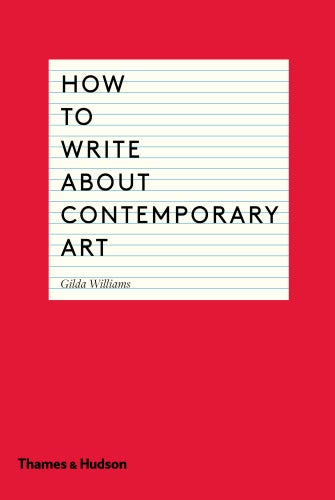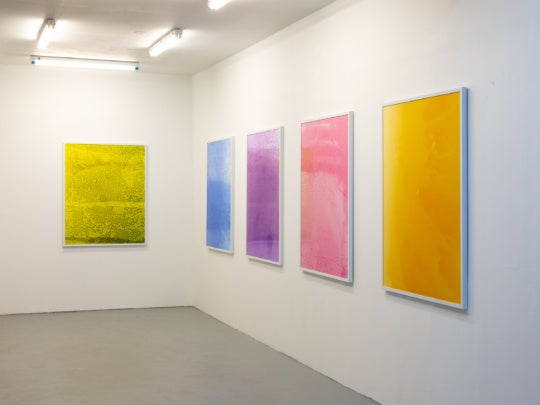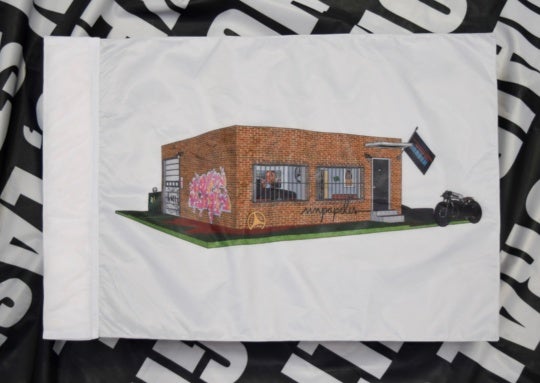
How do we define good art writing? What are some examples of art writing done well, and what purposes are served when we write about visual art?
In her new book, How to Write About Contemporary Art, London-based Artforum correspondent Gilda Williams illuminates contemporary art writing, providing insight into what we write about when we write about art. Williams tracks trends that show art writing moving away from so-called International Art English toward a more direct style of prose, offering examples of compelling writing that stretch back to the 1800s. She also reenvisions what it means to be a professional art writer and outlines the methods, ethics and even the financing that could see the role of the art writer codified and professionalized in a new and important way in the art world of tomorrow.
I recently conducted an interview with Williams via email, and her lucid, passionate responses offer a glimpse of what you’ll find between the covers of her new book.
Joe Nolan: Your examples of good art writing range from the 19th century to the 1940s, the 1980s and the 1990s. It seems we’ve always had good art writing. How has bad art writing persisted despite these revealing examples?
Gilda Williams: We barely admit it, and rarely read it, but the art world produces industrial quantities of text. Press releases, web blurbs, wall texts, museum brochures, artist’s statements, exhibition proposals, catalogue essays, and short entries for private collections, auctions and fairs. The art industry thrives on volumes of explanatory information—not just critical texts—aimed at every insider role, plus the world at large.
Weirdly, we regularly place this important task in the hands of our least knowledgeable, least experienced, least paid members: sub-assistants, entry-level staff, recent grads. International Art English—jargoned, easily mimicked, unintelligible, meaningless purple art-prose—is an emergency pseudo-language collectively invented by desperate and inexperienced art writers (often not writing in their native tongue) attempting a tough job for which they are unprepared. The technical term for this is “faking it.”
Good quality writing—like good-quality anything—costs money: considerably more than the embarrassing £100 [$160] per 600 words offered by one major London museum for its website entries, for example. This “salary” amounts to slightly less than what I pay my teenage babysitter—barely worth taking the morning off from one’s paper route. No wonder only a fresh-faced kid would accept it.
What makes the move from International Art English to a more straightforward critical prose an important one?
The art world—and its vast curious public—is starved for understandable, informative, stylish contemporary art writing to replace the artspeak slop that we are fed. Film writing, in comparison, is in a much healthier state—good film-writers offer intelligent, witty, and readable journalistic commentary even to some very serious films. It is no accident that many respected 21st-century artists are blessed with superb writing talents—John Kelsey, Hito Steyerl, Liam Gillick, Frances Stark, Seth Price, and Paul Chan come to mind. Language is fundamental for the circulation of 21st-century art.
What might the professionalization of art writing look like?
I fully support the creation of a new professional cast of art-writers: gifted communicators; immersed in and knowledgeable about contemporary art; possessing a natural inclination for writing; and earning a good living from their work. A precedent for this figure is Pat Hackett, Andy Warhol’s written “voice”—uncannily able to “sound like Andy” better than the artist himself. Hackett—paid decently, in direct conversation with the artist, and given a much-deserved co-author credit on Popism and The Diaries—was not an art critic but a commissioned literary spokesperson. Warhol was smart enough to recognize his limitations as a writer but hardly foolish enough to relegate “his” writing to amateurs. Thus he availed himself of professional art writers (Bob Colacello was another): this represents yet another prophetic Warholian solution in an evolving art world.
Like other art professionals, such as gallerists and curators, the art writer’s reputation would stand and fall on the quality of their work and the choices they make. The art writer would be an openly partisan collaborator, and free from the traditional conflicts of interest to which the art critic must submit. Top art writers, plainly working on behalf of galleries or artists, could be paid an advance or royalties on the sale of art; why not?
With art writing being so poorly compensated, why do people endeavor to do it?
For the very same reason that millions of low income artists carry on: they cannot help but do what they love. We bring home the bacon teaching and editing—moonlighting any art-related job that buys us time to write.
Commissioned writing pays so little I rarely bother. Worse still, some insensitive editors treat submissions like raw material to be manhandled and rewritten willy-nilly, a bad habit which definitively erases any writer’s desire to continue. Most of my hard-earned art-writing time goes towards crazy pet projects like my How to Write about Contemporary Art book, most of which I wrote purely for fun, without ever imagining I’d publish it.
You say, “much contemporary art writing is probably not actually meant to be read … but fills mostly ritualistic purposes.” What are these ritualistic purposes?
Most press releases are never read by the press. Most auction catalogue essays—the stuff printed beneath the technical info, provenance, and the estimated price—have no real readership. These are two examples of art-filler, stand-ins for actual content, fulfilling ritualistic functions expected to accompany the sale or exhibition of contemporary art. No one, not even future researchers, has any actual use for these empty words.
Many points in the book ask really challenging existential questions of art writing. My favorite: “Is art writing a parasite, a surplus cleaving itself onto art works better off without them?” Is art writing intrinsically parasitic?
Great art writing is thrilling to read, and a boon to art. Even the best art texts, however, can not compete with—much less replace—art itself. “Parasitic” may be too strong, but art writing must be second to art-making itself—precisely the way that exhibition-making and art-commerce fall second, in my opinion, to the making of art.
You write, “A critic’s methods, sense of ethics, and commitment will be assessed as much as their insight, choice of artist, or quality of published prose.” What are some examples of the solid methods, strong ethics and steady commitment that can support good art writing?
Whenever possible, write about the art you love. At least, be honest. Do your homework and provide real information. Put in the legwork, and go see as much new art as you can. Respect your readers, and write something worth reading.
Personally, I am extremely choosy about the artists and galleries I am willing to support with my writing. In return I expect reasonable pay and 100 percent editorial freedom. I refuse catalogue essays about dubious artists not just for ethical reasons, but because it is no fun writing about bad art.
Gilda Williams is a London correspondent for Artforum and lecturer at Goldsmiths College and Sotheby’s Institute of Art, London. From 1994 to 2005 she was editor and then commissioning editor at Phaidon Press. She is a former managing editor at Flash Art and her writing has appeared in Tate Etc., Parkett, Art Monthly, Art in America, and Time Out. Williams is author of The Gothic (2007) and has contributed to catalogues for exhibitions at London’s Whitechapel Art Gallery, the 48th Venice Biennale, and the Stedelijk Van Abbemuseum, Rotterdam, among others.
Joe Nolan is a critic, columnist, and intermedia artist in Nashville. Find out more about his projects at www.joenolan.com





